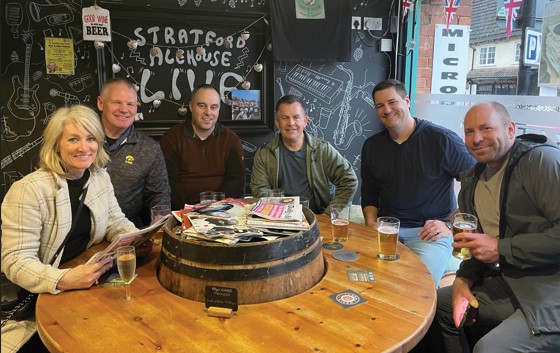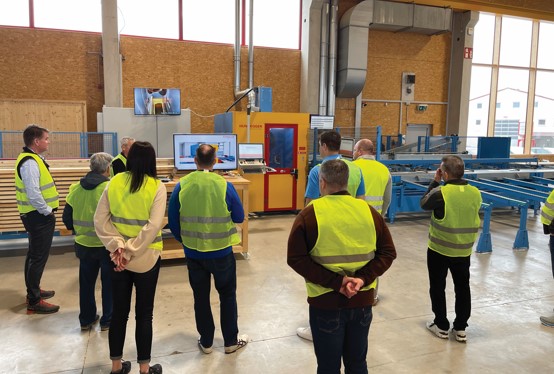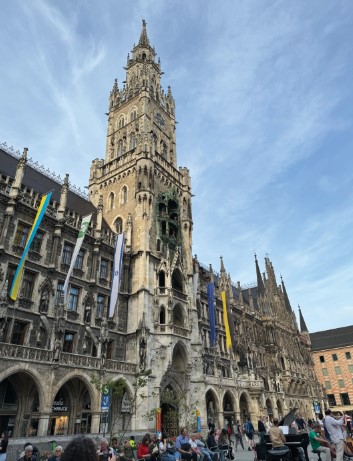An Invaluable Experience
Component Manufacturing Across the Pond
In April 2024, eight people from SBCA had the opportunity to travel to Europe for the first-ever SBCA European Offsite Tour.
 This idea came to fruition because of one of the three pillars of the SBCA’s multi-year strategic plan: to foster innovation in the component industry. To further that goal, SBCA organized an eight-day tour of industry specific innovation in Europe. From April 11th through the 18th, members joined tours of jobsites, facilities, and manufacturing plants throughout Europe. They toured jobsites in the United Kingdom to understand how Europeans utilized offsite manufactured floor systems; they visited homebuilders in Germany to understand how they incorporated offsite framing solutions, including closed wall panels; and they visited a robotic truss facility in Denmark to see how European component manufacturers approached advanced automation. Participants of the tour group included Adam Finkenhoefer of 84 Lumber; Gene Frogale of Blue Ocean Development; David Mitchell of Engineered Building Design; Randy Post and Justin Richardson of Richco Structures; Brent Wadas of BotBuilt; and Jess Lohse and Ali Saladin-Valerio of SBCA staff.
This idea came to fruition because of one of the three pillars of the SBCA’s multi-year strategic plan: to foster innovation in the component industry. To further that goal, SBCA organized an eight-day tour of industry specific innovation in Europe. From April 11th through the 18th, members joined tours of jobsites, facilities, and manufacturing plants throughout Europe. They toured jobsites in the United Kingdom to understand how Europeans utilized offsite manufactured floor systems; they visited homebuilders in Germany to understand how they incorporated offsite framing solutions, including closed wall panels; and they visited a robotic truss facility in Denmark to see how European component manufacturers approached advanced automation. Participants of the tour group included Adam Finkenhoefer of 84 Lumber; Gene Frogale of Blue Ocean Development; David Mitchell of Engineered Building Design; Randy Post and Justin Richardson of Richco Structures; Brent Wadas of BotBuilt; and Jess Lohse and Ali Saladin-Valerio of SBCA staff.
After the group returned from Europe, I sat down with each person to ask them about their experience. Through these conversations, I learned a lot and felt as if I had personally made the trip. The trip was fast-paced and packed full of educational and informational visits across the pond. This tour provided interesting insight into how diverse the cultures in Europe are when it comes to their construction industry, including their different types of equipment, methods, and the reasons behind why they do things the way they do. According to the group, the lumber quality was phenomenal, the attention to detail for safety was above and beyond, the use of automation was fascinating, and the culture and pride that comes from being a carpenter or working in the construction industry was inspiring.
 The group enjoys a pint at a local pub in Stratford-upon-Avon. Pictured (left to right): Shari Mitchell, Dave Mitchell, Jess Lohse, Randy Post, Adam Finkenhoefer, & Justin Richardson
The group enjoys a pint at a local pub in Stratford-upon-Avon. Pictured (left to right): Shari Mitchell, Dave Mitchell, Jess Lohse, Randy Post, Adam Finkenhoefer, & Justin Richardson
The group started their journey in Stratford-upon-Avon, England, visiting two “timber frame” manufacturers, or as we call it here in the U.S., component manufacturers. The group observed roof trusses, floor trusses, and wall panels being built with varying levels of automation. Several of those on the tour were fascinated by the use of MiTek’s Posi-Struts instead of open web trusses. Using the Posi-Strut metal webs for floor trusses allowed for them to lay out the trusses on the bottom and top sides of the table so there was no flipping involved.
Next up on the trip was a jobsite tour to see the components in use. A prerequisite for the trip was steel toed shoes; upon arrival, the group quickly realized why they were a requirement. “They had an elaborate fall protection system that I’ve never seen in the U.S.,” says Gene Frogale. “They had built up a platform on the second floor with a super safe railing. It was interesting to see.” These multi-story masonry buildings had scaffolding surrounding the entire perimeter and each of the interior rooms had platforms preventing falls to the interior of the building when working above. Several members of the group mentioned that the houses they saw in the UK’s residential areas were smaller in size and simpler: the trusses had no eaves and the houses were perfect rectangles – much different from what we’re used to here in the U.S., where there could be several profiles of trusses within just one home!
 UK Jobsite Safety efforts with extensive scaffolding seen on one of the group’s tours.
UK Jobsite Safety efforts with extensive scaffolding seen on one of the group’s tours.
After some downtime and individual travels over the weekend, the group reconvened in Munich, Germany. Here, they were able to see several Hundegger saws in action, as well as learn about various efforts to increase wood fiber utilization through buffering systems and unique material handling solutions. This is also where Hundegger presented the conceptional differences between mechanization and automation. “Automation vs. mechanization was eye-opening; it really showed just how much effort was put into their processes when including robotics. It was impressive,” says Ali Saladin-Valerio. It is easy to think that as soon as robots are involved, it’s all automation, but they explained that mechanization utilizes machines to reduce the amount of manual labor (replacing what people physically do) and automation implements technologies to carry out tasks autonomously (replacing what someone has to do, not the person). The robotics were very impressive to see live, which was a favorite among many of the group. “The promise of automation is huge,” says Gene Frogale. “Robotics are going to be a big step forward for U.S. truss manufacturing. There are certain things you can automate and other things you can’t. We learned a lot.” An interesting advantage that Europeans have and make use of is flawless lumber. “The perfect lumber is one reason why they are able to implement the automation before we are,” says Adam Finkenhoefer. “We have varying degrees of lumber quality, so it makes it more difficult for automated pickers, for example, to pick the best lumber for the component.”
 Examples of Posi Strut webbing from a UK manufacturer.
Examples of Posi Strut webbing from a UK manufacturer.
One major difference that was noted by several in the group was the German wall systems. Their wood-based walls are much wider and utilize significantly more wood fiber. While they are focused on being energy conscious and minimizing their carbon footprint by enclosing the walls with as much as possible prior to sending it out, the walls were just too thick. It’s uncertain if they’re as efficient as they’d like to be though. “We saw limited use of blown-in fiberglass insulation with large usage of cellulose or even proprietary wood fiber blends that utilize scrap lumber from manufacturing operations,” says Jess Lohse. “Given that the walls are 10”-13” thick, you could increase their R-value with a combo of spray foam and fiberglass.” Although it differs from what we do here in the U.S. and likely would not translate well here, what they’re doing is working for them and the results are positive, so it was interesting for the group to see.
Each of the facilities was incredibly clean, and everyone took pride in their work and businesses. Especially in Germany, which offers apprenticeship programs in which students start after high school or college, working alongside a master of the field. There are many families that have worked at these same places their whole lives, and it expands generationally. “The pride the carpenters and industry workers felt for what they did was astounding,” says Randy Post. “I was very impressed to see how honored they felt and just how loyal they were to their craft. It’s a different attitude and it was refreshing to see.” The carpenters in Germany have a uniform that they can wear once they become a master carpenter, in addition to a belt buckle to prove it.
While in Germany, Justin Richardson states, “I found that offsite construction, while popular, was actually necessary because they cannot have wet timber. Going into it, the initial thought was that the need for offsite stemmed mainly from labor issues, but in actuality, it was more of a regulatory issue.” To that end, they also cannot construct anything until there have been three days without rain. The whole house needs to be built inside, shrink-wrapped, and shipped on a truck to the site with crystal clear weather surrounding the drop-off.
 Example of the German wall system and material handling of the closed wall panels.
Example of the German wall system and material handling of the closed wall panels.
After Germany, the group continued on to Billund, Denmark to view an automated roof truss manufacturing line from Trussmatic. Trussmatic utilized a lumber scanning tool that observed piece characteristics as it passed on a conveyor. It identified lumber characteristics while also monitoring accuracy of the cutting including angles and lengths. This assured that there wouldn’t be any downstream difficulties with an errant piece and allowed for increased utilization at the assembly center. Something that was surprising was seeing how well the plants in Denmark had integrated robotics with human elements. “The psychology of humans working with robots is not as simple as one might think,” says Brent Wadas. “It’s not a one-size-fits-all. You have to be intentional with how you have the people engage with the robots and ensure the workers understand the value proposition of robotics as far as lifestyle goes. It was interesting to see how the plants in Denmark handled this, and how much they took that interaction into account when implementing these tools.” But it’s not just about robotics when it comes to a successful operation. No matter where the group toured, it was clear that the product material flow was consistent. “It’s the material flow through the plant that really matters,” says Dave Mitchell. “It doesn’t have to be a completely robotic system; it just has to be a complete system.” The folks in Denmark demonstrated that – they knew how to incorporate both robotics and people, creating an efficient and well-working material flow.
Some fun and interesting facts:
- In the UK, piggyback trusses are called top hats.
- Carpenters wear bell bottom pants in order to keep the sawdust out of their shoes.
- The places the group visited used their scrap wood for the boilers that heat their facilities.
- One of the plants had an in-house garden, cafeteria, and chef for their employees. They brought treating their employees like family to a whole new level.
- Pork Knuckle sandwiches are delicious.
- High Tea in London serves Champagne as well as tea.
 The group watches the automated sawing capabilities at a German manufacturing facility.
The group watches the automated sawing capabilities at a German manufacturing facility.
Overall, the beer and food were great, excitement and passion were abundant among the group, the people were friendly, and a lot was learned. Each person who participated in the SBCA European Offsite Tour had different motives for attending the trip, and at the end of it were very pleased they attended. For Brent Wadas of BotBuilt, his motive was to get more involved with SBCA, meet more liked-minded people, and see what else was out there. For Justin Richardson of Richco Structures, it was to gain perspective. At the end of the day, Justin wanted to see how others outside of our region, our country, and our market were doing it. Gene Frogale of Blue Ocean Development stated that he chose to go because he wanted to see the technology and how other countries were innovating. Whether it was to gain perspective, learn more about the broader industry, or learn about the technology and innovation, everyone who went stated that they would do another international offsite tour and would encourage others to do the same. It’s always interesting to see what others are doing, even in our own country; so, having the ability to experience what is being done in other parts of the world was eye-opening and created a hunger to learn even more. Justin states, “Anyone who is interested in learning more or broadening their perspective on the components industry should definitely make the trip.”
 Neues Rathaus (The New Town Hall) on Marienplatz in Munich, Germany.
Neues Rathaus (The New Town Hall) on Marienplatz in Munich, Germany.
If an international trip to visit offsite component manufacturers and builders interests you, please reach out to us. We are in the process of assessing interest for a future tour. Fill out this form here, https://bit.ly/4b4nsDH, or contact us at info@sbcacomponents.com.
We want to thank all of the people who welcomed the tours and opened their operations for the group to see, in addition to all those who helped organize this event and make it possible. Thank you to Donaldson Timber Systems, Crendon Timber Engineering, Whittle Gardens, Baufritz Factory, Taglieber Holzbau GmbH, Stark Zimmerei, Keitel Haus, Palsgaard Spaer, MiTek-UK, Hundegger, and Trussmatic Oy. And of course, a special thanks to SBCA staff’s very own, Ali Saladin-Valerio, for all of her hard work coordinating the travel and events, making this trip an absolute success!
Note of Contribution from the Author:
This article was written in collaboration with Jess Lohse, SBCA’s Executive Director. A special thanks to the tour participants for their willingness to share their experiences, photos, and interview for this article: Adam Finkenhoefer of 84 Lumber; Gene Frogale of Blue Ocean Development; David Mitchell of Engineered Building Design; Randy Post and Justin Richardson of Richco Structures; Brent Wadas of BotBuilt, and Ali Saladin-Valerio of SBCA staff. Thank you all for your contributions to this article.
Written by Christine Wagner
